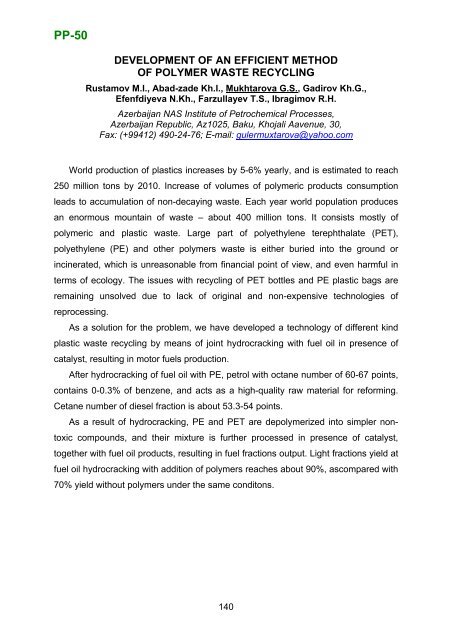Boreskov Institute of Catalysis SB RAS, Novosibirsk, Russia
Boreskov Institute of Catalysis SB RAS, Novosibirsk, Russia
Boreskov Institute of Catalysis SB RAS, Novosibirsk, Russia
- No tags were found...
You also want an ePaper? Increase the reach of your titles
YUMPU automatically turns print PDFs into web optimized ePapers that Google loves.
PP-50DEVELOPMENT OF AN EFFICIENT METHODOF POLYMER WASTE RECYCLINGRustamov M.I., Abad-zade Kh.I., Mukhtarova G.S., Gadirov Kh.G.,Efenfdiyeva N.Kh., Farzullayev T.S., Ibragimov R.H.Azerbaijan NAS <strong>Institute</strong> <strong>of</strong> Petrochemical Processes,Azerbaijan Republic, Az1025, Baku, Khojali Aavenue, 30,Fax: (+99412) 490-24-76; E-mail: gulermuxtarova@yahoo.comWorld production <strong>of</strong> plastics increases by 5-6% yearly, and is estimated to reach250 million tons by 2010. Increase <strong>of</strong> volumes <strong>of</strong> polymeric products consumptionleads to accumulation <strong>of</strong> non-decaying waste. Each year world population producesan enormous mountain <strong>of</strong> waste – about 400 million tons. It consists mostly <strong>of</strong>polymeric and plastic waste. Large part <strong>of</strong> polyethylene terephthalate (PET),polyethylene (PE) and other polymers waste is either buried into the ground orincinerated, which is unreasonable from financial point <strong>of</strong> view, and even harmful interms <strong>of</strong> ecology. The issues with recycling <strong>of</strong> PET bottles and PE plastic bags areremaining unsolved due to lack <strong>of</strong> original and non-expensive technologies <strong>of</strong>reprocessing.As a solution for the problem, we have developed a technology <strong>of</strong> different kindplastic waste recycling by means <strong>of</strong> joint hydrocracking with fuel oil in presence <strong>of</strong>catalyst, resulting in motor fuels production.After hydrocracking <strong>of</strong> fuel oil with PE, petrol with octane number <strong>of</strong> 60-67 points,contains 0-0.3% <strong>of</strong> benzene, and acts as a high-quality raw material for reforming.Cetane number <strong>of</strong> diesel fraction is about 53.3-54 points.As a result <strong>of</strong> hydrocracking, PE and PET are depolymerized into simpler nontoxiccompounds, and their mixture is further processed in presence <strong>of</strong> catalyst,together with fuel oil products, resulting in fuel fractions output. Light fractions yield atfuel oil hydrocracking with addition <strong>of</strong> polymers reaches about 90%, ascompared with70% yield without polymers under the same conditons.140
















